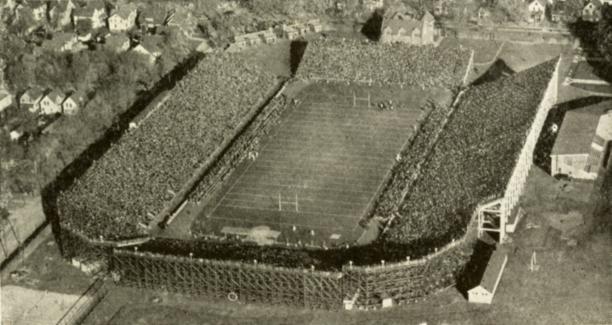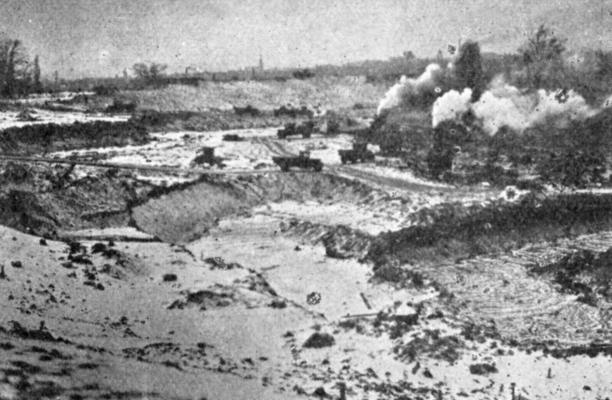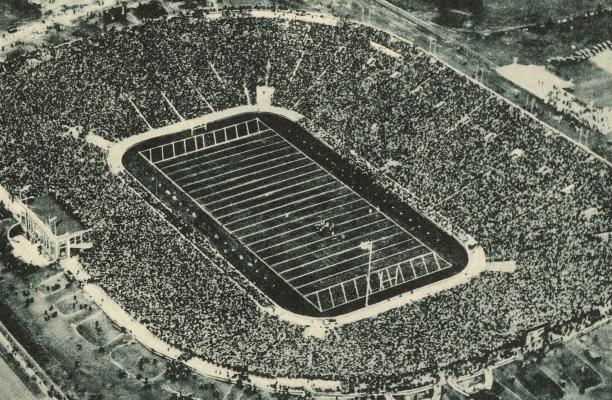Michigan Stadium
The biggest house for Football anywhere.
The University of Michigan Football team did not initially play at the facility we have today, which is now known as Michigan Stadium, or the Big House. Before Michigan Stadium was completed, the football team played in a variety of different locations before settling on a home. The first intercollegiate football game played on a home field for Michigan was in 1883, when they played the Detroit Independents at the Washtenaw County Fairgrounds. Michigan football continued to play games here for 10 years, except for the big games of the season, which were instead played in Detroit. The decision to move the big games to Detroit was made in order to accommodate the large number of traveling alumni wishing to come to the game.
With the growing interest in football, the university had to meet the needs of the students who wished to attend the games. After the students complained to the university that the current facilities were too small, Regents Field was constructed in order to house more fans. The field was completed in 1893 and after additions of grandstands and risers, it had space for over 15,000 attendees. The football team continued to use the facility until 1905. Like before, it was clear that the current field would not be large enough for the growing student population, so plans for a new field were made in 1902. The generous Detroit businessman Dexter Ferry, who was concerned with the lack of space available for athletics, bought a 20 acre plot of land north directly north of Regents Field. Combing the two plot of lands into one, which brought the total acreage to 38, Regents Field then became Ferry Field. Ferry donated over $30,000 in order for the facility to be built.

Ferry Field in 1924
Wishing to have an appearance of a larger field, Ferry also gave funds that would go towards the construction of a large brick wall and an ornamental gate to be built around the field. Initially, the total capacity of the field was 18,000, but after World War I, football once again increased in popularity, so more expansions had to be made. The seating room was doubled after renovations were done, but the University knew at the rate both football and the university were growing, Ferry field would not be adequate shortly. The football team welcomed in the new field with a 28-0 win over Case on October 6, 1906, and after their 21 seasons of playing there, ended with a record of 90 wins, 13 loses, and 2 ties. After the football team left, Ferry Field was the home for the Michigan Track and Field team, and it serves the same purpose today.
Aware of the need for proper facilities, the current coach at the time, Fielding Yost, put together a plan for a new, larger stadium, with the ticket revenue to go towards upgrading all the athletic facilities on campus. His plan was known as the day committee report. In order to pay for the $2,000,000 project, bonds were sold to alumni promising them quality seats in the new stadium for a period of years. In 1926, his plan was approved for a bowl simple in design, but that would seat over 72,000 fans. After approval, a field across the train tracks from Ferry Field was chosen to be the new home to Michigan Stadium and construction underwent to dig up the earth. However, during the excavation process, the workers hit a natural spring which flooded the field. The water made the field very difficult to dig through, and it caused many delays.

Construction of the stadium in 1927
Fielding Yost kept close attention to every detail of his masterpiece. Rather than following the structure of other bowls who had an ellipse shape, the architects instead decided to make the sidelines parallel to the field. The decision brought the spectators closer to the sideline, which provided for a satisfactory and exciting atmosphere. All characteristics of the stadium were carefully decided, even the exits and entrances, whose strategic position made it so the exact time to empty the stadium after a game was thirteen minutes. Following Yost’s plan, the stadium was designed with “the utmost simplicity. No attempt should be made to give it the form of a monument or memorial”. However, when author Adrian Wilson visited the stadium for the first time, he described it as “thrilling because of its vastness and the element of surprise, like coming upon Crater Lake or Grand Canyon”. Under Yost’s supervision, the stadium was finished on time and within budget.
The last pieces to be added to the stadium were the press box and locker rooms. After that, Michigan Stadium was ready for opening day on October 1, 1927. Rain had been flooding the field since the middle of the week, and it continued up until the start of the game. Despite the weather, the Wolverines won over Ohio Wesleyan 33-0 to a crowd between 30,000-40,000. Due to the success of the stadium and how much money it was raising, construction began on the facilities promised by Yost in his initial proposal. The Intramural Sports Building, forty tennis courts, and Palmer Field were constructed.

The Big House in 1935
The stadium was dedicated to the University on October 22, 1927 when Michigan played Ohio State. Michigan ended up beating Ohio State 21-0 on the day that would be further known as Dedication Day. The Governors from both Michigan and Ohio as well as the presidents from both Universities were present at the ceremony, as all four led the band onto the field. Temporary wooden bleachers, which continued to be used until 1949, had to be built for the over capacity crowd that was expected for the game. Even with the wooded bleachers that added an additional 10,000 seats, it was still a crowded game. Many fans had to watch the game from outside of stadium, as the attendance of the game was triple the total population of the city of Ann Arbor.
Renovations done to Michigan Stadium increased the capacity to well over 100,000, and Michigan held the record for the largest stadium in the United States. Michigan held the record for over 20 years but then lost it, however, when the University of Tennessee upgraded their stadium to outsize the Big House. This clearly upset the University, as more additions were made to the University the year after Tennessee stole the record. The renovations added another 5,000 seats, make Michigan Stadium the Big House once again.
Sources
-Wilson, Adrian P. The stadium. Middletown, CT: A.P. Wilson, 1951. Print. -“Michigan Stadium Story – Ferry Field.” BHL Header. N.p., n.d. Web. 15 Apr. 2017. -“Michigan Stadium.” Michigan Stadium. N.p., n.d. Web. 20 Apr. 2017. -“Michigan Stadium Story.” BHL Header. N.p., n.d. Web. 20 Apr. 2017.